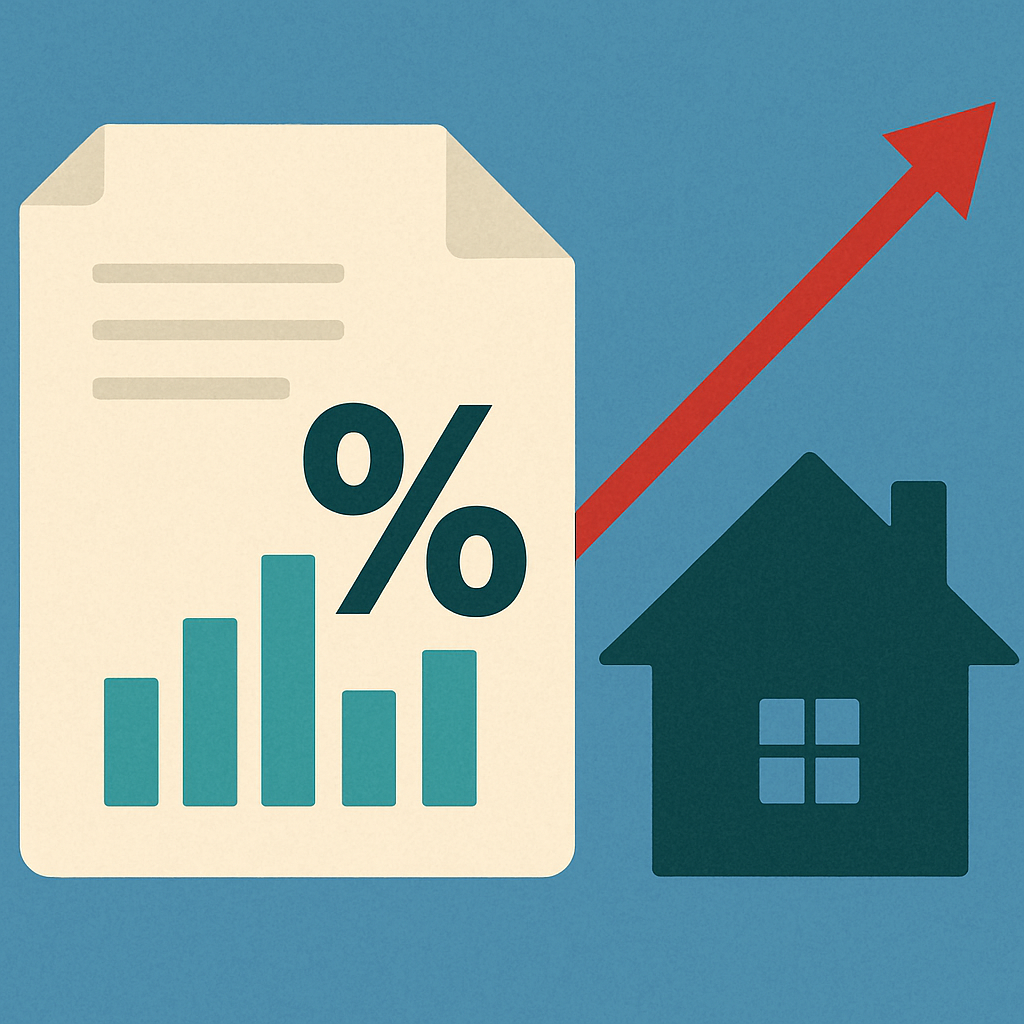

2025 Guide to Finding Assumable Mortgages & Securing Low Rates
What Is an Assumable Mortgage and How Does It Work?
An assumable mortgage or assumable home loan is a unique type of home financing arrangement that lets a buyer take over or "assume" an existing mortgage rather than take out a new loan. The buyer takes over the seller's existing mortgage and its original terms, including:
- The outstanding balance
- The interest rate
- The repayment period
- The contractual terms
With current mortgage rates fluctuating between the low-to-high 6% range, assumable mortgages can allow buyers to access lower interest rates.
For instance, a buyer in 2025 could get a new mortgage with an average interest rate of 6%. Alternatively, the buyer could take over an existing mortgage from 2020, when interest rates were much lower, with an average interest rate of 3%.
Simply put, when homebuyers assume a mortgage, they can capitalize on low interest rates, especially when current rates are prohibitive.
Which Mortgages Are Typically Assumable?
Not all mortgages are eligible for mortgage assumption. Most conventional and jumbo loans contain a due-on-sale clause, which lets the lender demand the entire loan balance when the property is sold or transferred. This clause effectively prevents mortgage assumption.
Bearing that in mind, these are the loans that typically qualify for mortgage assumption:
- FHA loans: Most government-backed loans, such as FHA loans, qualify for mortgage assumption. However, the buyer must meet FHA requirements to be eligible for an assumable FHA loan.
- VA loans: While VA loans are offered to members of the military and their spouses, one doesn't need military affiliation to qualify for a VA mortgage assumption. However, buyers must pay a VA funding fee and get approval from the lender and their regional VA loan office to assume a VA loan. But there's an exception: Buyers can freely assume loans issued before March 1, 1988, without approval from the VA loan office or lender.
- USDA loans: These loans are offered to buyers of rural homes and are assumable if the buyer meets USDA assumable loan requirements.
Assumable Vs. Non-Assumable Mortgage Loan Types
Mortgage TypeEligible for Assumption?Federal Housing Administration (FHA) loansYesDepartment of Veteran Affairs (VA) loansYesUnited States Department of Agriculture (USDA) loansYesConventional (private lender) loansNoJumbo loansNo
How to Find Current Assumable Mortgages
Finding an assumable mortgage can be difficult since only government-backed loans, such as FHA, VA, and USDA loans, are eligible. But the assumable loan search doesn't have to be daunting. Use these strategies to easily find current assumable mortgages.
Use Specialized Online Platforms
Assumable mortgages have rapidly become popular, as interest rates have soared. This has resulted in many people turning toward sites like Zillow, Redfin, and Realtor.com in search of assumable mortgages. While these major real estate sites allow prospective buyers to use keywords to find relevant listings, they don't have dedicated filters for assumable mortgages.
For instance, if you perform a keyword search for homes with assumable mortgages in San Antonio, TX, on Zillow, you'll only see about 90 properties. In contrast, you'll see over 1,600 homes on Assumable.io. That's why you should use dedicated assumable mortgage websites to find listings.
With over 50,000 nationwide listings, savings calculators, and payment estimates, Assumable.io helps buyers find assumable mortgages at low rates with minimal fuss.
Partner With a Reliable Real Estate Agent
A real estate agent with access to the Multiple Listing Service (MLS) can find properties that mention they have an assumable mortgage in the listing comments.
Work With a Title Company
Partner with a title company to find homes with government-backed loans. Once you find potential properties, contact homeowners directly to assess their interest in allowing you to take over their existing mortgage.
Focus on Distressed Properties
Homeowners who have defaulted on their loan obligations may be more receptive to an assumption to avoid foreclosure. However, this option requires additional cash to cover all past missed payments, interest accrued, or late penalties.
Steps to Assume a Mortgage Successfully
If you want to assume another homeowner's mortgage, follow these assumable loan steps:
Check Loan Eligibility for Assumption
First, confirm the loan is assumable. You can do this by checking the loan's terms or contacting the lender directly to ascertain whether the loan allows for assumption under its terms. As mentioned previously, generally, most government-backed loans qualify for assumption.
Meet Lender Qualification Requirements
Buyers must meet certain criteria to qualify for a mortgage assumption. Similar to a traditional mortgage, most lenders require buyers to provide proof of income, employment history, and undergo a credit check. This information allows lenders to assess the buyer's ability to pay the mortgage.
For example, buyers who wish to assume an FHA loan must have a credit score of at least 580 and a debt-to-income (DTI) ratio of 43% or lower.
Understand and Pay the Required Down Payment or Equity
While mortgage assumption allows buyers to take advantage of low interest rates, it doesn't cover any equity the seller has built. Equity is the difference between the home's market value and the remaining mortgage balance. This means that if the home's value has appreciated since the original loan was issued, the buyer must cover the difference.
For example, if the seller has a mortgage balance of $250,000 on a $500,000 home, the buyer must make up the difference of $250,000 in cash or through financing to pay the seller for equity built up in the home.
Want to purchase your dream home but can't raise the required equity? Don't worry. We work with lenders who can provide the secondary financing you need to close the equity gap.
Complete the Lender's Assumption Approval Process
When buyers assume a mortgage, they're taking over an existing loan. As a result, lenders often require buyers to undergo the same application process and fulfill similar requirements as new loan applicants.
Lenders typically require buyers to provide the following documentation to assess their creditworthiness:
- Tax returns (usually two years)
- Proof of income
- Bank statements
- Credit report
- Employment verification
- List of assets and debts
Once the lender evaluates these documents and confirms the buyer's eligibility, the lender will finalize the assumption process.
Mortgage assumptions attract an assumption fee (usually roughly 0.5% to 1% of the outstanding loan balance), but it may vary depending on the lender and loan type. In some cases, mortgage insurance premiums may also apply.
Ideally, experts recommend that buyers prepare their financial documents and discuss timelines with lenders early to make the assumable mortgage process seamless.
Finalize Legal Documentation and Release Seller Liability
Like a traditional home purchase, a mortgage assumption involves closing paperwork. The buyer must pay the assumption fee and sign an assumption agreement, transferring the mortgage from the seller to the buyer.
Sellers should also sign a mortgage release of liability document provided by their lender to show that the buyer is legally responsible for the loan; otherwise, they may remain liable even after the buyer assumes the loan.
Conduct Home Inspection and Closing
Assumable mortgages don't guarantee a property is in good condition. As a result, buyers should perform a full home inspection before closing to identify potential safety issues, defects, and items requiring repair.
While a full home inspection can increase closing costs, especially if it reveals serious issues, it can lead to significant future cost savings. If the home inspection doesn't reveal any major problems, the seller can transfer the title to the buyer, finalize payments, and close the sale.
Benefits of Assuming a Mortgage in 2025
Assumable mortgages are an attractive home financing option for various reasons. Here are the top benefits of assumable mortgages for buyers.
Lower Interest Rates
In a rising interest environment, buyers can make huge savings with assumable loans. Assuming a mortgage with a lower interest rate lets buyers reduce their monthly payments and save thousands of dollars over the loan's duration.
For example, buyers looking for affordable home financing in 2025 may benefit from assuming a mortgage from 2020, when interest averaged 3%.
Lower Closing Costs
Assumable mortgages often have lower closing costs, as there's usually no home appraisal required. Additionally, closing costs are capped on certain government-insured mortgages. For instance, FHA assumption fees are capped at $1,800.
Faster Qualification
Applying for a traditional mortgage can be relatively time-consuming. In contrast, the mortgage assumption process can be quicker since the lender has already vetted and approved the original borrower.
Competitive Edge for Sellers
Sellers who provide assumable mortgages can make their properties appealing to buyers looking to secure lower interest rates, particularly when rates are high. This can help sellers struggling to find buyers set their listings apart and transfer home ownership faster.
Important Considerations and Potential Drawbacks
While assumable mortgages offer several benefits, they have some downsides. Here are some of their potential drawbacks.
Limited Mortgage Options
Not all mortgages qualify for assumption. Generally, only properties with government-backed loans have assumable mortgages. Additionally, since homes with FHA, VA, and USDA loans have lower mortgage rates, sellers hold onto them for longer.
As a result, buyers looking for assumable mortgages often have fewer options than buyers seeking traditional mortgages.
Substantial Down Payment
Buyers may require a huge initial amount of cash if the seller has built a significant amount of equity in the home. This may make assuming a mortgage costlier than taking a traditional mortgage. Fortunately, we offer secondary loans to buyers who can't cover the equity payout.
Restricted Lender Choice
Buyers who choose to assume a mortgage are confined to the original borrower's lender. They can't shop around and compare what other lenders offer.
Advantages and Disadvantages of Assumable Mortgages
ProsConsLower interest rates for buyersLimited mortgage options for sellersLower closing costs for homebuyersSubstantial down payment costs for buyersFaster qualification for buyersRestricted lender choice for homebuyersCompetitive edge for sellersIncreased risk for sellers
Tips for ensuring a successful assumption
If you want to lock in the best assumable mortgage rates, keep these tips for assuming a mortgage in mind:
- Gather all documentation early: Lenders require various documents to approve mortgage assumptions. Get all the documents you need in order before starting the assumption process for quicker approval.
- Compare total costs: While assumable mortgages typically offer favorable interest rates compared to traditional ones, you should still compare costs. Review the existing mortgage terms, including the interest rate, remaining balance, repayment period, contractual terms, insurance fees, and equity requirements, to ensure the mortgage offers good value for money.
- Consult a real estate attorney: Understanding the intricacies of mortgage assumptions can be challenging, especially in complex transactions. If you're unsure about anything, seek legal advice.
Pro tip: Finding assumable mortgages with low interest rates can be difficult and time-consuming. Use online tools like Assumable.io to save time and effort. These tools provide savings calculators and payment estimates, enabling buyers to secure assumable loans easily.
Frequently Asked Questions About Assumable Mortgages
What is an assumable mortgage, and how does it work?
An assumable mortgage lets a buyer take over a seller's existing mortgage rather than take out a new loan. The buyer takes over the current mortgage, including its outstanding balance, interest rate, repayment period, and contractual terms.
Which types of loans are assumable?
Government-backed loans, such as FHA, VA, and USDA loans, are assumable, while most conventional and jumbo loans aren't assumable.
What are the benefits of assuming a mortgage?
The primary benefit of assuming a mortgage is securing a lower interest rate, which can result in lower monthly payments and significant cost savings over the loan's duration.
How do I find current assumable mortgages?
You can partner with a reputable real estate agent or title company to find current assumable mortgages in your area. You can also search for homes with assumable loans using specialized online tools like Assumable.
What are the requirements to qualify for an assumable mortgage?
Buyers must meet the lender's credit, income, and debt-to-income (DTI) ratio requirements and undergo an approval process to be eligible for an assumable mortgage.
Are there extra costs or fees when assuming a mortgage?
Mortgage assumptions attract additional costs like assumption fees, closing costs, and mortgage insurance premiums, depending on the loan type. Buyers may also need to pay the seller a down payment if the seller has built equity in the home.
Can anyone assume a mortgage, or does it have to be a family member?
Anyone can assume a mortgage if they meet the lender's requirements. The buyer doesn't need to be related to the seller.
What happens to the seller's liability and credit after the mortgage is assumed?
The seller remains liable for the debt after the buyer assumes the mortgage, unless the lender provides a release of liability document that the seller signs.
What is the outlook for mortgage rates in 2025, and is now a good time to assume a mortgage?
Market analysts expect mortgage rates to remain above 6% in 2025, making assumable mortgages attractive for homebuyers seeking lower interest rates.
Do I need mortgage insurance for an assumable FHA or USDA loan?
Assumable FHA and USDA loans require buyers who assume a mortgage to pay mortgage insurance premiums monthly to protect lenders from potentially hefty losses.










